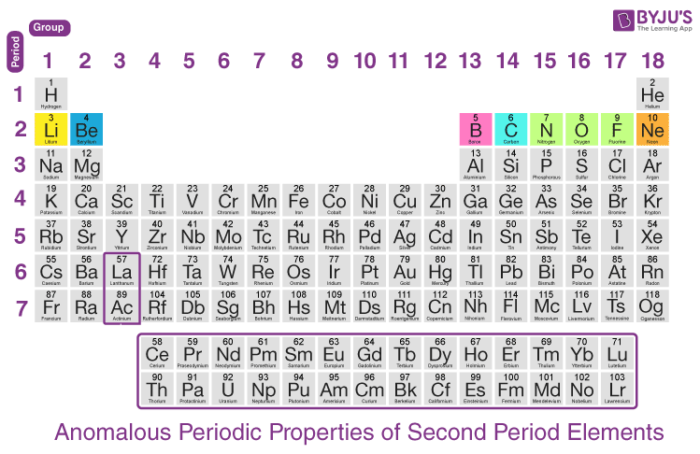What are Anomalous Periodic Properties?
All elements are special in their own way even if there are certain trends that have been observed by scientists over the years. The elements belonging to the second period display periodic properties that are especially anomalous.
Let’s take a look at the elements that belong to the second period first:

Diagonal Relationship
It has been observed that Lithium, Beryllium, Boron, Carbon, Nitrogen, Oxygen, and Fluorine have slightly different periodic properties than the rest of the elements belonging to Group 1, 2, 13-17 respectively. For example, Lithium and Beryllium form covalent compounds, whereas the rest of the members of Groups 1 and 2 form ionic compounds. Also, the oxide that is formed by Beryllium when it reacts with Oxygen is amphoteric in nature, unlike other Group 2 elements that form basic oxides. Yet another example is that of Carbon which can form stable multiple bonds, whereas Si=Si double bonds are not very common.
So, it has clearly been established that the second-period elements are different. In fact, they display periodic properties that are similar to the second element of the next group (i.e. Lithium is similar to Magnesium and Beryllium to Aluminium) in other words, they have a diagonal relationship.
Reasons for Anomalous Periodic Properties
The reasons for differences in periodic properties and hence in chemical behaviour are:
- Small size of these atoms
- High electronegativity
- Large charge/radius ratio
- These elements also have only 4 valence orbitals available (2s and 2p) for bonding as compared to the 9 available (3s, 3p, and 3d) to the other members of the respective groups, so their maximum covalency is 4. (This is why Boron can only form [BF4]– whereas Aluminium can form [AlF6]3-).
These are the reasons for anomalous periodic properties of second-period elements, but there are several other normal trends in the periodic table as well.
Recommended Videos

Frequently Asked Questions – FAQs
What is an anomalous pair of elements?
Anomalous pairs are those pairs of elements which have not obeyed the increasing order of atomic masses. Mendeleev placed these elements in properties, and not in the increasing order of their atomic mass, according to similarity.
What are the anomalous properties of nitrogen?
Nitrogen is small, strongly electronegative, has high energy for ionization and the lack of valence electrons in d orbital oxygen indicates anomalous behaviour. Nitrogen is diatomic while it is polyatomic to others. Nitrogen is a gas whilst others are solids
What are bridge elements give example?
Bridge elements are objects belonging to periodic table period 2. They are named so because they are diagonally identical in the property i.e. the elements of period 2 exhibit similarity to the elements in the next category in period 3 namely lithium magnesium; beryllium; aluminium; boron silicon etc.
What are the 7 periods of the periodic table?
A cycle is a series of periodic table horizontally. The periodic table comprises seven periods, with each starting at the far left. When a new key energy stage starts to fill with electrons a new cycle starts. Phase 1 contains only two elements (hydrogen and helium), while Phase 2 and Period 3 have 8.
What are typical elements?
The third period elements of the periodic table are known as typical elements because they don’t show anomalous properties with their respective groups. These elements are also called representative elements. These are sodium, magnesium, aluminium, silicon, phosphorus, sulfur, chlorine, and argon.
To know more about these periodic properties, visit www.byjus.com or download BYJU’S – The Learning App.

nice